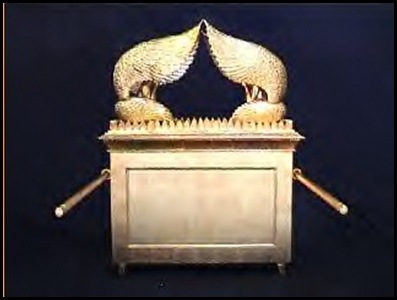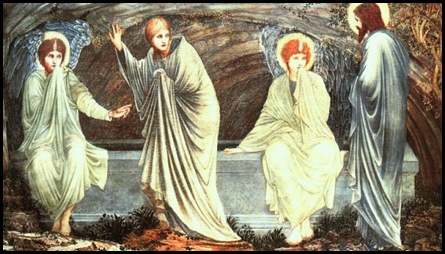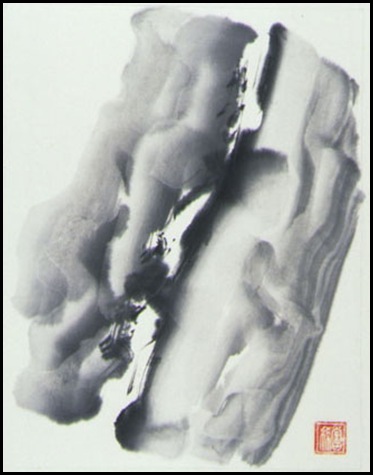The spirituality of the Jewish world in which Jesus lived was marked by separation. A prayer from Jesus’ day read
“Blessed is he who distinguishes between the holy and the profane, between light and darkness, between Israel and Gentiles, between the seventh day and the six working days, between water above and water below, between priest and Levite and Israelite.”
Holiness was marked by keeping the clean away from the unclean, the righteous from the sinner. Perhaps the most marked distinction was between what was alive and what was dead. The High Priest was not even allowed to acknowledge death and was forbidden to take part in the funeral rites even of his closest family.
The religious rites of the Temple were also ordered in this way with a succession of areas which one could only enter after successive levels of purification. Yet even when one kept all of the laws the presence of God was still closed off. At the very end of the Temple was the great veil or curtain that hid the Holy of Holies. Behind the veil was the Ark of the Covenant flanked by two golden Cherubim between which was the Mercy Seat of God. This was the place where the presence of God dwelt. Only one person, the High Priest, ever beheld it and then only on one day of the year, the Day of Atonement, so he could sprinkle the blood of propitiation upon the Mercy Seat. For everyone else the Mercy Seat of God was forever hidden and out of reach.
The holiness of Jesus was in marked opposition to this holiness of separation or Puritanism. He broke the Sabbath laws, did not keep the customs of ritual cleansing, associated with collaborators, with prostitutes and even let them touch Him. He touched lepers and the handicapped and even the dead. He taught us about finding Him in the sick and the imprisoned and the hungry, He taught us about gathering in the beggars from the streets to dine at the banqueting table of God. The theologian Nicholas Boyle wrote:
“The presence of what is alien, pagan, unholy, unclean at the heart of the Church is essential to its nature. When the Church finds what is unholy, then it must say ‘For this too Christ died’...In such moments the Church too must die, must swallow its pride, give up the boundary which it thought defined its existence, and discover a new and larger vocation. And that new vocation will itself be defined by a new boundary which in time the Church will also have to transcend.”
So you would assume that the Church would be the first community to recognise when it is defining itself as an ‘us’ against a ‘them’. If only it were so. Our history is one long, continual, struggle against the old purity holiness of the temple. There is always a new ‘them’. For the Anglican Communion today it is either ‘conservatives’ or ‘liberals’, ‘orthodox’ or ‘heretics’. Usually these lines are drawn because of differing understandings of human sexual orientation. There will always be some tribal, clan identity against which we will attempt to define ourselves against. The saddest part is that this type of spirituality discredits all religion and even makes it dangerous to humanity.
We should not be overly harsh with ourselves however because we evolved this way. From our earliest days we lived in small groups that were always on the lookout for the ‘other’ tribe who was out to get us. We are, after all, a particularly violent species. Even today, when we are threatened our first response in to retreat back into the clan for protection. In a world that has dramatically changed almost overnight most people feel threatened. For most of the world’s population their most primal clan identity is that of their religion. Of course this is not real religion in that true religion is not afraid and seeks to move outwards in worship to explore in faith the creation and all other creatures. Instead it is the opposite of faith – it is created out of fear. Thus this world is filled with fundamentalists whose hardness of heart too often betrays the absence of love and a fearless faith.
Father Timothy Radcliffe, the former Master of the Dominican Order (who introduced to me the concept behind this article), said in his book Why Go to Church:
“And who are the people whom we, the Church, thrust out, or at least leave hanging around on the edge, as second class citizens: the divorced and remarried, people living with partners, gay people. There must be a place for them around our altars, rejoicing in Christ’s hospitality along with everyone else. Often our Churches keep alive Old Testament understanding of holiness, separating off our communities from those who have gone astray. This may look like keeping up standards, refusing the moral relativism, but actually it is just failing to catch up with the novel holiness of Christ.”
We must keep pushing outwards to grow and be transformed like I discussed in my last column. For us as Christians this means seeking Christ in one another especially in those we find alien – the stranger and the enemy. He is seldom where we want Him to be. I never tire of reminding people that Elie Wiesel thought that if you had to choose between Christ and the Truth you must always choose the truth because if you choose Christ you are only choosing who you think He is, an idol of Him, and not who He really is. Remember the disciples did not recognise Him after He had risen. Mary Magdalene was looking for him in the tomb and did not recognise Him when He stood outside of it but rather thought He was the gardener.
At the Easter Day Mass this year most of us read the Resurrection account by St Luke:
“They found the stone rolled away from the tomb, but when they went in, they did not find the body. While they were perplexed about this, suddenly two men in dazzling clothes stood beside them. The women were terrified and bowed their faces to the ground, but the men said to them, ‘Why do you look for the living among the dead? He is not here, but has risen.’” LUKE 24:1-5
On Good Friday we read the Passion according to St Luke:
“It was now about the sixth hour, and there was darkness over the whole eland until the ninth hour, while the sun’s light failed: and the curtain of the temple was torn in two.” LUKE 23:44-45
Even more dramatic is St Mathews account:
“And behold, the curtain of the temple was torn in two, from top to bottom; and the earth shook, and the rocks were split...” MATHEW 27:51
Do you see it? When Christ died the veil of the temple was ‘rent in twain’ revealing the Holy of Holies – the empty space between the two Cherubim – the Mercy Seat of God. That which had remained hidden, cut off from the people because they were not pure enough, was revealed - an empty space between two angels. God was no longer separated from His people. He was no longer to be found there.
On Easter morning a group of women, the very first people to encounter this new reality, found another empty space flanked by two angels. He was not there either.
The first painting is by Sir Edward Coley Burne-Jones entitled ‘Mary Magdalene and the Risen Lord’.
The second painting is by Joseph Love and is a Sumi ink drawing entitled ‘The Veil oft he Temple was Torn’.




